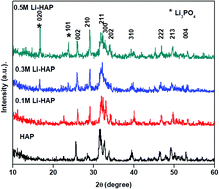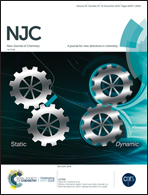Advanced lithium substituted hydroxyapatite nanoparticles for antimicrobial and hemolytic studies
Abstract
In this study, pure hydroxyapatite (HAP) and lithium substituted hydroxyapatite (Li-HAP) nanoparticles were synthesized by a sonochemical synthesis process and investigated for their antimicrobial and hemolytic activities. The synthesized HAP and Li-HAP were characterized by X-ray diffraction (XRD), scanning electron microscopy (SEM), transmission electron microscopy (TEM) and Fourier transform infrared (FTIR) spectroscopy. The XRD analysis confirmed the formation of the HAP phase both in the synthesized pure HAP and Li-HAP samples. It was also observed that the crystallite size was decreased in Li-HAP compared to pure HAP. FTIR analysis confirmed the presence of various functional groups (e.g. hydroxyl, phosphate etc. groups). Generally, hydroxyapatite has a rod and plate-like morphology. Upon doping, the rod and plate-like morphologies were modified to agglomerated needle-shaped HAP crystals. Antimicrobial, hemolytic and MTT studies were performed using human pathogens, human blood, and human bone cells, respectively, to investigate the biological activities of the synthesized HAP samples. The biological test results evidenced the biocompatibility and cytotoxicity of the HAP samples with better functionality of Li-HAP.



 Please wait while we load your content...
Please wait while we load your content...